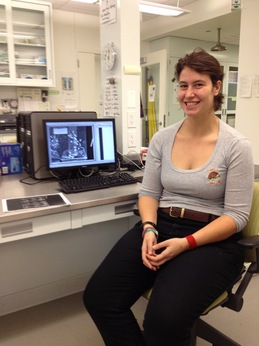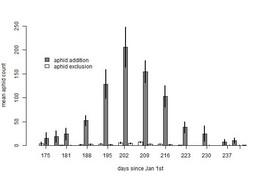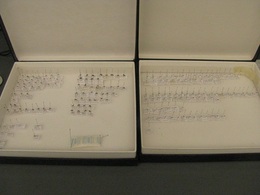|
|
Gia gave a presentation at the NU research expo. Here are the details…
Hallaman, G. “Ant Diversity for Six Western Minnesota Tallgrass Prairie Remnants: The Connection between Ants and Echinacea angustifolia.” Northwestern Undergraduate Research and Arts Exposition, June 2, Evanston, IL USA, 2014 (Oral Presentation).
Last week I gave a public presentation describing my M.S. thesis with the Echinacea Project. After two summers of field work and eight months of data analysis and writing, I managed to succeed in passing my defense. I have included a link to my presentation slides. They do not include much in the way of explanatory text, but they have an abundance of pictures and graphs along with a dash of poetry.

ThesisPresentationFinal.pdf
We have two interns pursuing independent projects in the lab. Jill Pastick, a junior at Lakeforest College, is testing out different methods of germinating Echinacea achenes and helping us prepare the germination phase of two ongoing experiments.

Gia Hallaman, a junior at Northwestern, is helping out with several projects, including counting achenes in x-ray images from Jill’s germination experiment (you can see them on the computer screen below). She is also learning how to identify ants to morphospecies. That means distinguishing different species based on morphology and making our best guess on which species they are. It takes time to develop an eye for the different traits that distinguish closely related species; often the most obvious traits, like color and size, are not informative for differentiating species. Jill is learning to use a combination of tools, including online dichotomous keys and photo databases (antweb.org), to identify ants to species or morphospecies. With her help, we should be able to make a dent in identifying the ants we collected from Minnesota prairie remnants in the summer of 2012.

During the summers of 2011 and 2012, I conducted a survey of aphid infestation in a section of the main experimental plot to track, among other things, seasonal changes in the distribution and abundance of Aphis echinaceae on Echinacea. With help from members of team Echinacea, I conducted 6 bi-weekly surveys in 2011 and 3 monthly surveys in 2012. In both years there was a sharp rise and fall in the frequency of aphid infestation. The plot below shows the percentage of plants in the survey area observed to have 1 or more aphids on each dates. In 2011, the peak of aphid infestation (i.e. when the highest percentage of plants hosted aphids) was around August 12th. In 2012, the peak date of aphid infestation occurred some time between July 13th and August 9th. I was not able to observe the peak directly due to a sudden die-off of aphids before my third survey. I estimated the peak frequency of aphids as the percentage of plants with live or dead aphids on August 10th (indicated by the asterix and x-error bar).

I was also able to get a sense of aphid phenology from my aphid addition/exclusion experiment. In 2011 and 2012, I added or excluded aphids from 100 plants that were not flowering in 2011. The graph below shows the mean abundance of aphids in each experimental group over the summer of 2012:

Based on this graph, I estimate that the peak of aphid infestation for 2012 occurred around July 22nd (202 days after January 1st), about two weeks before last year’s peak.
This summer, REU student Jill Gall put together a large collection of ants from prairie remnants in Minnesota. Yesterday, Stuart and I headed over to Lakeforest College to seek the advice of resident ant ecologist Sean Menke. Jill left us with two boxes of ants, which she pinned and identified to genus and separated into morphotypes:

Sean was impressed with her identification skills: she was correct in nearly every identification to genus and many of her morphotypes were consistent. He gave us some tips on what traits to look for when identifying ants. Now we have a plan for going through the rest of the collection. This will allow us to compare the species diversity of ants among prairie remnants, and hopefully pave the way for future ant research in the lab.

|
|

-thumb-260x346-154543.jpg)





